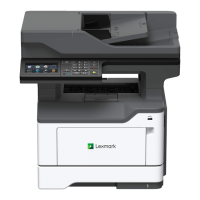The paper then actuates the sensors (pick and deskew). The sensor (pick) detects the leading edge of the paper
and adjusts the pick/feed timings while the sensor (deskew) detects the paper for any skews. The deskew roller
slows down the paper to perform the skew correction.
Note: The motor (pick) runs the pick and feed rollers.
After the skew correction is completed, the transport roller advances the paper to the scan area. But before
the image acquisition process could start, the paper has to actuate the sensor (ADF scan). Failure to actuate
the sensor results to a paper jam. The first side of the document is scanned.
If the scan job is simplex, exit roller 1 advances the paper until it is picked up and moved by the exit roller 2 into
the ADF bin. The motor (transport) runs the transport, deskew, and exit rollers.
If the scan job is duplex, then the motor (pick) rotation is reversed such that exit roller 2 pulls the paper back
into the ADF. The paper actuates the sensor (ADF pick), and then moves until it reaches the scan area for the
second time. Like the first pass of the paper, the image acquisition process is repeated for the second side of
the paper. Before the paper exits, it goes back again to the ADF for the third time, but no imaging occurs. This
pass is to turn the paper over to the original side up. On the third pass of the paper, exit roller 2 does not reverse
and the paper passes out of the ADF.
ADF paper path sensors
7017-2xx, -4xx, -6xx
Theory of operation
384

